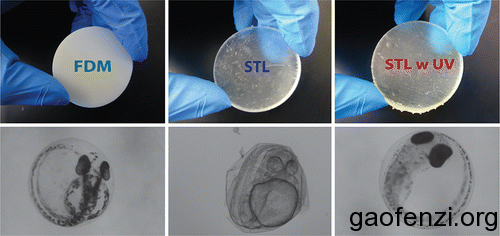近期,加州大学研究人员们发表论文称斑马鱼胚胎接触一些3D打印部件时以惊人的速度死亡,这项研究结果将3D打印材料对于环境影响的问题凸显了出来,尤其是那些回收的打印材料。
研究人员们使用了熔融沉积(FDM)和光固化(SLT)两种3D打印机打印了大量盘形塑件,然后这些盘子培养斑马鱼胚胎,随后研究了这些胚胎的生存率、孵化率和发育异常的问题。

研究发现,使用FDM 3D打印机打印出的塑料部件下的胚胎平均生存率比对照组胚胎略有下降,而使用液态树脂3D打印的部件使胚胎存活率明显下降,在第三天就有超过一半的死亡,到第七天全部死亡,并且那些孵出后被暴露于用液态树脂3D打印的部件上的一些斑马鱼胚胎,100%地显示出发育异常。
但是,研究人员研究发现使用紫外线照射即可成功地降低这些光固化3D打印部件的毒性,对这些3D打印部件进行紫外线照射一小时后,它们对斑马鱼胚胎的毒性显著变小。
参考文献:Assessing and Reducing the Toxicity of 3D-Printed Parts,Environ. Sci. Technol. Lett., DOI: 10.1021/acs.estlett.5b00249.摘要:3D printing is gaining popularity by providing a tool for fast, cost-effective, and highly customizable fabrication. However, little is known about the toxicity of 3D-printed objects. In this work, we assess the toxicity of printed parts from two main classes of commercial 3D printers, fused deposition modeling and stereolithography. We assessed the toxicity of these 3D-printed parts using zebrafish (Danio rerio), a widely used model organism in aquatic toxicology. Zebrafish embryos were exposed to 3D-printed parts and monitored for rates of survival, hatching, and developmental abnormalities. We found that parts from both types of printers were measurably toxic to zebrafish embryos, with STL-printed parts significantly more toxic than FDM-printed parts. We also developed a simple post-printing treatment (exposure to ultraviolet light) that largely mitigates the toxicity of the STL-printed parts. Our results call attention to the need for strategies for the safe disposal of 3D-printed parts and printer waste materials.
小编点评:3d打印日益在医疗领域发挥重要作用,3D打印材料或产品的生物相容性值得大家关注。本文资料来源:加州大学官网,转载请注明来源【高分子网gaofenzi.org】